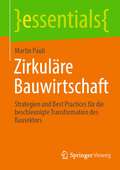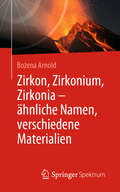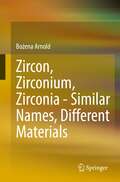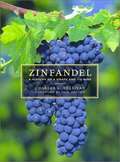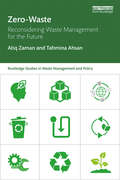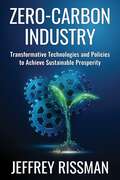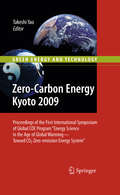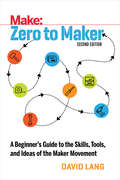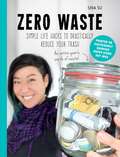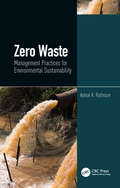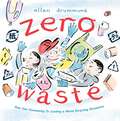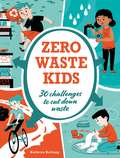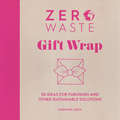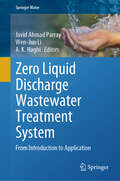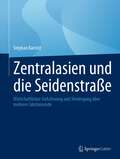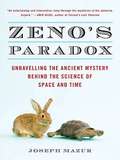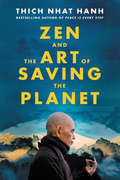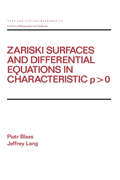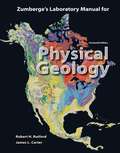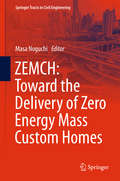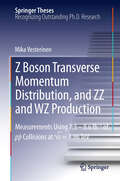- Table View
- List View
Zirkuläre Bauwirtschaft: Strategien und Best Practices für die beschleunigte Transformation des Bausektors (essentials)
by Martin PauliDieses Essential fasst prägnant zusammen, warum die Prinzipien der Kreislaufwirtschaft für die Bauwirtschaft im Kontext von Klimawandel und zunehmender Ressourcenknappheit unabdingbar sind. Es gibt Einblicke in Umsetzungsstrategien und Projektbeispiele, beleuchtet die elementaren Methoden zur Messbarkeit von sektorspezifischen CO2-Emissionen und wirft einen systemischen Blick auf die Wertschöpfungskette Bau sowie die Implikationen, Potenziale und Risiken der Umsetzung.
Zirkon, Zirkonium, Zirkonia - ähnliche Namen, verschiedene Materialien
by Bożena ArnoldIm vorliegenden Buch finden Sie viele spannende und oft erstaunliche Informationen über diese außergewöhnlichen und vielfältigen Materialien. Die Darstellung ist im Wesentlichen chronologisch aufgebaut und folgt der Geschichte der Entdeckung dieser Materialien. Dabei werden ihre Eigenschaften und Anwendungsbereiche beschrieben. Das Buch stellt eine Mischung aus Fach- und Sachbuch dar: verständlich für Fachleute und Laien.
Zircon, Zirconium, Zirconia - Similar Names, Different Materials
by Bożena ArnoldIn this book you will find a lot of exciting and often astonishing information about these extraordinary and diverse materials. The presentation is essentially structured chronologically and follows the history of the discovery of these materials. Their properties and areas of application are described. The book is a mixture of specialist and non-fiction: understandable for experts and laypeople.This book is a translation of the original German 1st edition Zirkon, Zirkonium, Zirkonia - ähnliche Namen, verschiedene Materialien by Bożena Arnold, published by Springer-Verlag GmbH Germany, part of Springer Nature in 2019. The translation was done with the help of artificial intelligence (machine translation by the service DeepL.com). A subsequent human revision was done primarily in terms of content, so that the book will read stylistically differently from a conventional translation. Springer Nature works continuously to further the development of tools for the production of books and on the related technologies to support the authors.
Zinfandel: A History of a Grape and Its Wine
by Charles L. SullivanThe Zinfandel grape--currently producing big, rich, luscious styles of red wine--has a large, loyal, even fanatical following in California and around the world. The grape, grown predominantly in California, has acquired an almost mythic status--in part because of the caliber of its wines and its remarkable versatility, and in part because of the mystery surrounding its origins. Charles Sullivan, a leading expert on the history of California wine, has at last written the definitive history of Zinfandel. Here he brings together his deep knowledge of wine with the results of his extensive research on the grape in the United States and Europe in a book that will entertain and enlighten wine aficionados and casual enthusiasts. In this lively book, Sullivan dispels the false legend that has obscured Zinfandel's history for almost a century, reveals the latest scientific findings about the grape's European roots, shares his thoughts on the quality of the wines now being produced, and looks to the future of this remarkable grape. Sullivan reconstructs Zinfandel's journey through history--taking us from Austria to the East Coast of the U. S. in the 1820s, to Gold Rush California, and through the early days of the state's wine industry. He considers the ups and downs of the grape's popularity, including its most recent and, according to Sullivan, most brilliant "up. " He also unravels the two great mysteries surrounding Zinfandel: the myth of Agoston Haraszthy's role in importing Zinfandel, and the heated controversy over the relationship between California Zinfandel and Italian Primitivo. Sullivan ends with his assessments of the 2001 and 2002 vintages, firmly setting the history of Zinfandel into the chronicles of grape history.
Zhang Heng and the Incredible Earthquake Detector
by Randel McGeeZhang Heng, a brilliant inventor and advisor to the emperor, must create a device that can determine where an earthquake took place. Told in the dying art of Chinese shadow puppetry, this true story of the first seismograph will entertain and educate.
Zeros of Polynomials and Solvable Nonlinear Evolution Equations
by Francesco CalogeroReporting a novel breakthrough in the identification and investigation of solvable and integrable nonlinearly coupled evolution ordinary differential equations (ODEs) or partial differential equations (PDEs), this text includes practical examples throughout to illustrate the theoretical concepts. Beginning with systems of ODEs, including second-order ODEs of Newtonian type, it then discusses systems of PDEs, and systems evolving in discrete time. It reports a novel, differential algorithm which can be used to evaluate all the zeros of a generic polynomial of arbitrary degree: a remarkable development of a fundamental mathematical problem with a long history. The book will be of interest to applied mathematicians and mathematical physicists working in the area of integrable and solvable non-linear evolution equations; it can also be used as supplementary reading material for general applied mathematics or mathematical physics courses.
Zero-Waste: Reconsidering Waste Management for the Future (Routledge Studies in Waste Management and Policy)
by Atiq Zaman Tahmina AhsanThis book analyses ‘zero-waste’ (ZW) as an emerging waste management strategy for the future, which considers waste prevention through innovative design and sustainable consumption practices. Drawing on a diverse range of case studies from Australia, Bangladesh, Japan, New Zealand, Sweden, and the USA, this book explores why urban waste management systems still remain a major challenge for almost all cities around the world. Rejecting waste as an ‘end-of-life’ problem, Atiq Zaman and Tahmina Ahsan instead consider waste prevention through the ZW model, in which resources are utilized and consumed with minimum environmental degradation. In addition, the authors give extended discussion on why embracing the ZW concept will be beneficial for the circular economy (CE). Providing a strategic zero-waste framework and an evaluation tool to measure waste management performance aimed towards ZW goals, this book will be of great relevance to students, scholars, and policymakers with an interest in waste management, sustainable consumption, urban planning, and sustainable development.
Zero-Carbon Industry: Transformative Technologies and Policies to Achieve Sustainable Prosperity (Center on Global Energy Policy Series)
by Jeffrey RissmanThe power sector and transportation tend to dominate conversations about climate change, but there’s an under-the-radar source of climate pollution that must be addressed: industry. Globally, industrial activity is responsible for one-third of human-caused greenhouse gas emissions. Though industry is a major emitter, it is essential for producing the tools we need to fight climate change—like wind turbines, solar panels, and electric vehicles—and for meeting our everyday needs. How can industry eliminate its climate pollution while supplying transformational technologies?This book delivers a first-of-its-kind roadmap for the zero-carbon industrial transition, spotlighting the breakthrough innovations transforming the manufacturing sector and the policies that can accelerate this global shift. Jeffrey Rissman illustrates the scope of the challenge, diving into the workings of heavy polluters like steel, chemicals, plastics, cement, and concrete. He examines ways to affordably decarbonize manufacturing, such as electrifying industrial processes, using hydrogen, deploying carbon capture and storage, and growing material efficiency with lightweighting and 3D printing. But technologies are only part of the picture. Enacting the right policies—including financial incentives, research and development support, well-designed carbon pricing, efficiency and emissions standards, and green public procurement—can spur investment and hasten emissions reductions. Rissman provides a framework to ensure that the transition to clean industry enhances equity, health, and prosperity for communities worldwide.Engaging and comprehensive, Zero-Carbon Industry is the definitive guide to decarbonizing the vast—yet often overlooked—global industrial sector.
Zero-Carbon Energy Kyoto 2012
by Takeshi YaoThe Global COE is setting out a zero-emission technology roadmap and is promoting socioeconomic studies of energy, studies of new technologies for renewable energies, and research for advanced nuclear energy. It has also established the Global COE Unit for Energy Science Education to support young researchers as they apply their skills and knowledge and a broad international perspective to respond to issues of energy and the environment in our societies. This book follows on the earlier volumes Zero-Carbon Energy Kyoto 2009, 2010, and 2011.
Zero to Maker: A Beginner's Guide to the Skills, Tools, and Ideas of the Maker Movement
by David LangZero to Maker is part memoir and part how-to guidebook for anyone who is having thoughts like these:I feel like all I can do is write emails. I wish I had more hands-on skills even though I don't know what I would build...I have this one idea I've always wanted to make, but I don't know how to build it...I keep hearing about the "maker movement" but I'm not sure what that means or how I can join in...The book follows author David Lang's headfirst dive into the maker world and shows how he grew from an unskilled beginner to be a successful entrepreneur. You'll discover how to navigate this new community of makers, and find the best resources for learning the tools and skills you need to be a dynamic maker in your own right.The way we make things has changed. A new generation of tinkerers have emerged through online communities and powerful digital fabrication tools, and their creations are changing the world. This book follows the author's personal journey of transformation into a maker-entrepreneur. It is everyone's guide to combining inspiration and resources to effectively navigate this exciting new world.Lang reveals how he became a maker pro after losing his job and how the experience helped him start OpenROV, a DIY community and product line focused on underwater robotics. It all happened once he became an active member of the maker movement. Ready to take the plunge into the next Industrial Revolution? This guide provides a clear and inspiring roadmap.Take an eye-opening journey from unskilled observer to engaged makerLearn how to join this community, get access to tools and experts, and pick up new skillsUse a template for building a maker-based entrepreneurial lifestyle and prepare yourself for the careers of the futureThis book is for everyone who dreams of becoming a successful maker-entrepreneur. It not only satisfies the aspirational aspect but shows newcomers to the maker movement exactly how to join in.First published in 2013, this new edition features full-color photos and shares David's latest insights and experiences as he continues to grow as a maker entrepreneur and citizen scientist.
Zero Waste: Simple Life Hacks to Drastically Reduce Your Trash
by Shia SuEasy and Effective Strategies to Jumpstart a Sustainable, Waste-Free Lifestyle We have a worldwide trash epidemic. The average American disposes of 4.4 pounds of garbage per day, and our landfills hold 254 million tons of waste. What if there were a simple—and fun—way for you to make a difference? What if you could take charge of your own waste, reduce your carbon footprint, and make an individual impact on an already fragile environment? A zero waste lifestyle is the answer—and Shia Su is living it. Every single piece of unrecyclable garbage Shia has produced in one year fits into a mason jar—and if it seems overwhelming, it isn’t! In Zero Waste, Shia demystifies and simplifies the zero waste lifestyle for the beginner, sharing practical advice, quick solutions, and tips and tricks that will make trash-free living fun and meaningful. Learn how to: Build your own zero waste kitPrepare real food—the lazy wayMake your own DIY household cleaners and toiletriesBe zero waste even in the bathroom!And more! Be part of the solution! Implement these small changes at your own pace, and restructure your life to one of sustainable living for your community, your health, and the earth that sustains you.
Zero Waste: Management Practices for Environmental Sustainability
by Ashok K. RathoureZero Waste: Management Practices for Environmental Sustainability presents approaches for resource management centered on reducing waste and reusing and recycling materials. It aims to save energy by reducing energy consumption associated with extracting, processing, and transporting raw materials and waste, and also to reduce and eventually eliminate the need for landfills and incinerators. This book presents the various principles, methods, and tools that can be used to address different issues in the areas of industrial waste reduction and sustainability. It examines how to eliminate waste at the source and at all points of a supply chain, and how to shift from the current one-way linear resource model to a sustainable "closed-loop" system. Proposes strategies for businesses to reduce and reuse waste with a goal of reaching a zero waste status. Focuses on how mitigating waste and promoting recycling can save vast amounts of energy. Explains how the zero waste approach would be a key measure to ensure environmental sustainability and help to offset global climate change.
Zero Waste: How One Community Is Leading a World Recycling Revolution (Green Power)
by Allan DrummondIn this fifth installment in Allan Drummond’s picture book series about green living, a town in Japan takes a stand against its throwaway past and shows that it really does take a village to make sustainable change.Kamikatsu, Japan is known worldwide for its sanitation innovations. This small community of 1700 people is leading the way in recycling and up-cycling, and as of 2022, had nearly achieved its goal of zero waste. Told in Allan's hallmark narrative style, Zero Waste is the story of a group of citizens who dared to break out of their comfort zone and make radical change for the good of their town and the planet. Through the eyes of two children visiting their grandmother, this inspiring addition to the author’s acclaimed Green Power series about everyday communities inventing exciting new approaches to green living shows that working together for a common cause has an impact that is lasting, meaningful—and fun!
Zero Waste Kids
by Kathryn KelloggOur planet is in danger! It's time to make a difference to ensure its future by taking up the zero-waste challenge. Zero Waste Kids is full of fun ways to help you make sustainable choices to save planet Earth. Become informed about the crisis we're in but also, more importantly, take action through the 30 achievable child-friendly challenges to reduce waste, including craft activities and lifestyle changes to reduce, reuse and recycle your way to a better future.Filled with facts about the state of our planet, the environmental impact of over-consuming and the waste we produce and where it goes.Written by US author Kathryn Kellogg, a leading voice in the zero-waste movement, author of the adult book 101 Ways to Go Zero Waste, founder of the Going Zero Waste blog, featured in publications such as National Geographic, The Times, the Guardian, CNN.
Zero Waste Gift Wrap
by Christine LeechInventive ways to wrap presents that are both pretty and planet-friendly!Embrace zero waste living with this collection of sustainable gift wrap solutions including furoshiki, the traditional Japanese technique of fabric knotting. What could be nicer than receiving a present AND the beautiful scarf it's wrapped in!Whether you use a vintage silk scarf or create your own fabric with patchwork, piecing, and dyeing techniques—or reuse unwanted items to make quirky gift wraps—this collection is packed full of ideas for reducing waste.Other ideas include how to make present toppers made from unwanted fabric and yarn scraps—to finish off your gift wrapping with a flourish.
Zero Liquid Discharge Wastewater Treatment System: From Introduction to Application (Springer Water)
by Javid Ahmad Parray Wen-Jun Li A. K. HaghiA Zero Liquid Discharge System (ZLDS) is a process that recovers water and solvents from wastewater. The remaining constituents are dehydrated to form pure water, resulting in zero waste. This book is a unique research-oriented guide covering the entire zero-liquid discharge process, from its introduction to its application. Zero liquid discharge water treatment plants require high engineering expertise and careful planning to achieve zero shots. Although it is an efficient wastewater treatment technique, improper industrial wastewater disposal can lead to environmental hazards such as water and soil pollution. This book focuses on ecological degradation and delves deeply into the consequences of improper industrial wastewater disposal, highlighting its effects on water pollution, ecosystem imbalance, and risks to human health. It offers a detailed examination of the resulting contamination and its far-reaching implications, emphasizing the need for proper disposal methods. One of the most critical needs for a healthy life is to provide healthy water and contaminants to be taken from the public water supplies. The book may reflect the healthy situation in many by presenting best practices, aiming to foster an understanding of the role of chemical contaminants in water systems in mitigating environmental hazards and the application of "zero liquid discharge technology" in detail. As industrial pollution continues to rise, there is a need to explore practical ways of managing industrial residues from wastewater. This book presents innovative research on using a "zero liquid discharge system" to achieve this locally and internationally. It also examines appropriate resource management strategies to address environmental concerns. This book critically reviews the health effects of industrial chemicals in the water supply. It examines current frameworks' limitations, challenges, and opportunities and discusses the benefits of using a "zero liquid discharge system" and their impact on global sustainability. The book also emphasizes this technology to limit toxic industrial material utilization. This chapter provides an overview of the occurrence of industrial chemicals in drinking water and the associated human health risks. This book also analyzes existing policies related to industrial wastewater and proposes policy recommendations for effective wastewater management using a zero-liquid discharge system. It discusses implementation strategies and policy adoption, emphasizing the role of policy in shaping and improving industrial wastewater management frameworks. The edited volume aims to highlight the critical operating factors and consider the large capital investments of this system and the operational costs. However, in this research-oriented book, the readers will clearly understand that this novel system can leave behind a dry sludge containing high concentrations of hazardous chemicals and heavy metals. This edited volume will show that the application of a Zero Liquid Discharge System (ZLDS) requires careful planning and analysis.
Zero Degrees: Geographies of the Prime Meridian
by Charles W. WithersCharles Withers explains how the choice of Greenwich to mark 0° longitude solved problems of global measurement that had engaged geographers, astronomers, and mariners since ancient times. This history is a testament to the power of maps, the challenges of global measurement, and the role of scientific authority in creating the modern world.
Zentralasien und die Seidenstraße: Wirtschaftlicher Aufschwung und Niedergang über mehrere Jahrtausende
by Stephan BarisitzDieses Buch bietet einen umfassenden Überblick über die vormoderne Wirtschaftsgeschichte Zentralasiens und der Seidenstraße, die mehrere Jahrtausende umfasst. Durch die Analyse einer Fülle von Quellen und Materialien veranschaulicht es die wiederholten wirtschaftlichen Blütezeiten der Seidenstraße, in denen sie über viele Jahrhunderte Orient und Okzident verband. Nomadische Steppenreiche beherrschten häufig Zentralasien, prägten dessen Wirtschaft und beeinflussten den Handel entlang der Seidenstraße. Das Buch untersucht die Ursachen und Auswirkungen des weitreichenden Booms des Überlandhandels und erörtert gleichzeitig verschiedene interne und externe Faktoren, die zum allmählichen wirtschaftlichen Niedergang Zentralasiens und letztlichzum Ende der Seidenstraße führten. Schließlich wird erläutert, wie der wirtschaftliche Niedergang zum chinesischen und russischen Kolonialismus im 18. und 19. Jahrhundert beitrug. Detaillierte Informationen, z.B. über den Verlauf der Seidenstraße in den verschiedenen Epochen, werden in Form zahlreicher neu erstellter Karten angeboten.
Zeno's Paradox
by Joseph MazurThe fascinating story of an ancient riddle?and what it reveals about the nature of time and space Three millennia ago, the Greek philosopher Zeno constructed a series of logical paradoxes to prove that motion is impossible. Today, these paradoxes remain on the cutting edge of our investigations into the fabric of space and time. Zeno?s Paradox uses the motion paradox as a jumping-off point for an exploration of the twenty-five-hundred-year quest to uncover the true nature of the universe. From Galileo to Einstein to Stephen Hawking, some of the greatest minds in history have tackled the problem and made spectacular breakthroughs?but through it all, the paradox of motion remains. .
Zen and the Art of Saving the Planet
by Thich Nhat Hanh“When you wake up and you see that the Earth is not just the environment, the Earth is us, you touch the nature of interbeing. And at that moment you can have real communication with the Earth… We have to wake up together. And if we wake up together, then we have a chance. Our way of living our life and planning our future has led us into this situation. And now we need to look deeply to find a way out, not only as individuals, but as a collective, a species.”-- Thich Nhat HanhWe face a potent intersection of crises: ecological destruction, rising inequality, racial injustice, and the lasting impacts of a devastating pandemic. The situation is beyond urgent. To face these challenges, we need to find ways to strengthen our clarity, compassion, and courage to act.Beloved Zen Master Thich Nhat Hanh is blazingly clear: there’s one thing we all have the power to change, which can make all the difference, and that is our mind. Our way of looking, seeing, and thinking determines every choice we make, the everyday actions we take or avoid, how we relate to those we love or oppose, and how we react in a crisis.Mindfulness and the radical insights of Zen meditation can give us the strength and clarity we need to help create a regenerative world in which all life is respected. Filled with Thich Nhat Hanh’s inspiring meditations, Zen stories and experiences from his own activism, as well as commentary from Sister True Dedication, one of his students Zen and the Art of Saving the Planet shows us a new way of seeing and living that can bring healing and harmony to ourselves, our relationships, and the Earth.
Zariski Surfaces and Differential Equations in Characteristic P < O (Chapman And Hall/crc Pure And Applied Mathematics Ser. #106)
by Piotr BlassThis book represents the current (1985) state of knowledge about Zariski surfaces and related topics in differential equations in characteristic p > 0. It is aimed at research mathematicians and graduate and advanced undergraduate students of mathematics and computer science.
ZUMBERGE'S LABORATORY MANUAL FOR Physical Geology
by James Zumberge Robert H. Rutford James L. CarterLaboratory Manual for Physical Geology, 14e is written for the freshman-level laboratory course in physical geology. In this lab, students study Earth materials, geologic interpretation of topographic maps, aerial photographs and Earth satellite imagery, structural geology and plate tectonics and related phenomena. With over 30 exercises, professors have great flexibility when developing the syllabus for their physical geology lab course.
ZEMCH: Toward the Delivery of Zero Energy Mass Custom Homes
by Masa NoguchiIn this book, leading international experts explore the emerging concept of the zero energy mass custom home (ZEMCH) - designed to meet the need for social, economic, and environmental sustainability - and provide all of the knowledge required for the delivery of zero energy mass customized housing and community developments in developed and developing countries. The coverage is wide ranging, progressing from explanation of the meaning of sustainable development to discussion of challenges and trends in mass housing, the advantages and disadvantages of prefabricated methods of construction, and the concepts of mass customization, mass personalization, and inclusive design. A chapter on energy use will aid the reader in designing and retrofitting housing to reduce energy demand and/or improve energy end‐use efficiency. Passive design strategies and active technologies (especially solar) are thoroughly reviewed. Application of the ZEMCH construction criteria to new buildings and refurbishment of old houses is explained and the methods and value of building performance simulation, analyzed. The concluding chapter presents examples of ZEMCH projects from around the world, with discussion of marketing strategy, design, quality assurance, and delivery challenges. The book will be invaluable as a training/teaching tool for both students and industry partners.
ZEDlife
by Bill DunsterThe argument for low-cost, zero-energy, zero-waste architecture has never been timelier, while the mainstream has largely abandoned or neglected this agenda: in the UK the recent mandatory zero-carbon performance targets for new homes have been postponed or forgotten at a time when thousands of new homes will be built, and there is already a shortage of electric generating capacity. This book offers a forceful challenge to the current addiction to overconsumption of natural capital and energy, and provides workable, sustainable solutions for zero-carbon, zero-waste design.
Z Boson Transverse Momentum Distribution, and ZZ and WZ Production
by Mika VesterinenThis work develops novel data analysis techniques enabling aspects of the Standard Model of particle physics to be tested with unprecedented precision using data from the DZero experiment at the high energy "Tevatron" proton-antiproton collider at Fermilab, Chicago. Vesterinen's measurements of the transverse momentum of Z bosons using the novel variable φ* have exposed deficiencies in the current state-of-the-art theoretical predictions for vector boson production at hadron colliders. These techniques are now being used in the experiments at CERN's Large Hadron Collider (LHC) and have stimulated considerable interest in the theoretical particle physics community. Furthermore, Vesterinen's measurements of the cross sections for the production of pairs of vector bosons (WZ and ZZ) are to date the most precise ever made.
